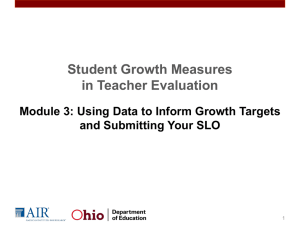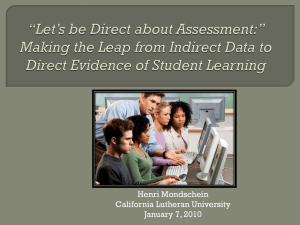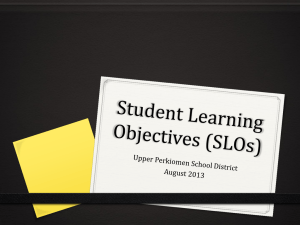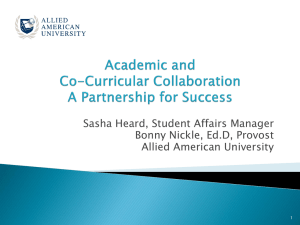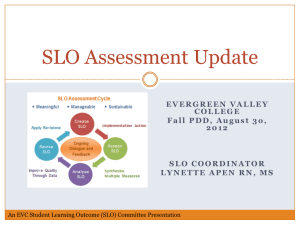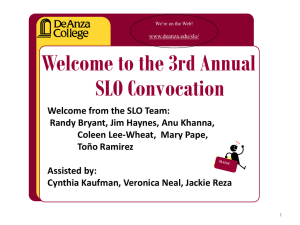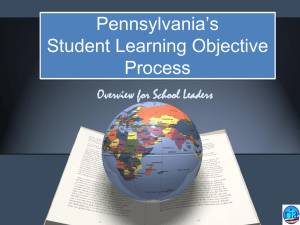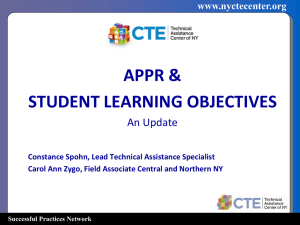(SLOs 101) (PPT)
advertisement
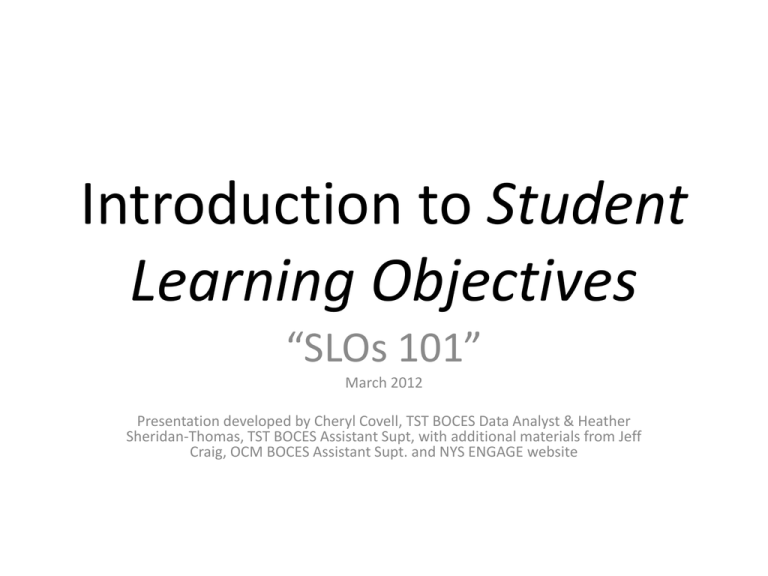
Introduction to Student Learning Objectives “SLOs 101” March 2012 Presentation developed by Cheryl Covell, TST BOCES Data Analyst & Heather Sheridan-Thomas, TST BOCES Assistant Supt, with additional materials from Jeff Craig, OCM BOCES Assistant Supt. and NYS ENGAGE website Session Objectives • Understand how Student Learning Objectives fit into the overall NYS Teacher Evaluation system and Race to the Top initiative. • Develop a beginning awareness of WHAT an SLO is, WHO needs SLOs, HOW SLO decisions are made, and WHY SLOs are an important element in an overall effort to enhance teaching and learning. NY State’s Regulations governing teacher evaluation call for a “State-determined District-wide growth goal setting process.” 60% • Observations and other tools 20% • Locally selected measure 20% • Student Growth via: • State provided growth score • SLO NO Stateprovided Growth Score; Use Student Learning Objectives State-provided Growth Score What Are Student Learning Objectives (SLOs)? NYSED SLO Framework All SLOs MUST include the following basic components: Student Population Which students are being addressed? Learning Content What is being taught? CCSS/National/State standards? Will this goal apply to all standards applicable to a course or just to specific priority standards? Interval of Instructional Time What is the instructional period covered (if not a year, rationale for semester/quarter/etc)? Evidence What assessment(s) or student work product(s) will be used to measure this goal? Baseline What is the starting level of learning for students covered by this SLO? Target(s) What is the expected outcome (target) by the end of the instructional period? HEDI Criteria How will evaluators determine what range of student performance “meets” the goal (effective) versus “well-below” (ineffective) , “below” (developing), and “well-above” (highly effective)? Rationale Why choose this learning content, evidence and target? 6 Example of an SLO (Part 1) Population Learning Content Interval Evidence Baseline 7 Spanish II Class; all 30 students New York State Learning Standards for Languages Other Than English (LOTE) SY 2012-13 (1 year) 1.Spanish I summative assessment results from students in 2011-12. 2.District-wide pre-assessment administered at the beginning of the school year. 3.District-wide summative assessment administered at the end of the school year. 1.All students had 2011-12 Spanish I results that demonstrated scores of proficient or higher in all basic vocabulary and grammar. 2.Scores ranged from 6% - 43% on the Spanish II Districtwide diagnostic assessment. Example of an SLO (Part 2) 80% of students will demonstrate mastery of at least 75% of the Spanish II performance indicators, as measured by the district’s summative assessment in May 2012. Target(s) and HEDI Scoring Rationale 8 Highly Effective (18-20 points) Effective (9-17 points) Developing (3-8 points) Ineffective (0-2 points) 86-100% of students demonstrate mastery of 75% of the Spanish II performance indicators. 78% -85% of students demonstrate mastery of 75% of the Spanish II performance indicators. 66% - 77% of students demonstrate mastery of 75% of the Spanish II performance indicators. 65% or less of students demonstrate mastery of 75% of the Spanish II performance indicators. Previous work in Spanish I focused on working with basic vocabulary and grammar, and building preliminary oral skills. The diagnostic assessment is heavily focused on more advanced writing and reading skills, which are essential components of the Spanish curriculum. Spanish II requires students build on their learning from Spanish I in order to acquire mastery in these areas and to be prepared for Spanish III. Since all students completed Spanish I having achieved basic proficiency levels, I am confident they will achieve 80% mastery or above on at least 75% of the Spanish II materials. Example of an SLO (Part 1)DRAFT Population Learning Content Interval Grade 2 students (22 students in a class) ELA Common Core Learning Standards (Prioritize Rdg Info Text 1,2,4,6,10 ; Found Sk 3, 4; Language 4) SY 2013-2014 (1 year) 1. STAR assessment results Evidence Baseline Data includes: 1.District Reading Assessment 2.District Writing Assessment 1. 82% of students demonstrated proficiency on 1st grade end-of-year Baseline 9 STAR assessment. 2. 77% of students demonstrated proficiency on 2nd grade STAR preassessment. 3. 80% of students demonstrated grade level proficiency in reading on district benchmark assessments (DRA 2) by end of 1st grade 4. 7o% of students demonstrated proficiency on district created benchmark writing assessment in Sept 2012 Example of an SLO (Part 2) DRAFT 85 % of all student will demonstrate grade level proficiency in reading as measured by the STAR assessment administered in May 2013. OR 90% of students will demonstrate at least one year’s growth from September 2012 to June 2013, as measured by STAR assessment. Target(s) and HEDI Scoring Rationale 10 Highly Effective (18-20 points) Effective (9-17 points) Developing (3-8 points) Ineffective (0-2 points) 86-100% of students demonstrate proficiency. OR 91-100% of students show at least 1 yr. growth. 78% -85% of students demonstrate proficiency. OR 81-90% of students show at least 1 yr. growth. 66% - 77% of students demonstrate mastery proficiency. OR 71% - 80 of students show at least 1 yr. growth. 65% or less of students demonstrate proficiency. OR 65% or less show growth of 1 year. Learning Content is prioritized to reflect ELA Shifts 1,3,4 & 6. Writing will be assessed as local assessment. Targets:Results from 1st grade STAR end of year assessments suggest 82 % of students are proficient. Sept 2012 results suggest 77 % proficiency (possible “summer slide”) District assessment results suggest 80 % grade level proficiency in reading and a bit lower in writing (72%). An 85% proficiency goal seems reasonable, as it is above results from previous year and fall pre-assessment. If a true growth goal is set, a more challenging 90% is reasonable, because difference in student starting points are considered. State • Determines SLO process • Identifies required elements District • District goals & priorities School • LE & teacher collaborate • Match Teacher requirements to • Requires use • LE approval • Works with teachers of State test • Ensure security colleagues & • Define LE • Provides • LE monitor & training to NTs processes for before & after evaluation prior to 201213. • Identify • Provides guidance, webinars & videos expectations SLOs The STATE determines the following: o The overall SLO framework. o Which teachers must set SLOs and which teachers must have State-provided growth measures. o Which assessments must be used, and which are allowable options. o Requirements around scoring: • The scoring ranges and categories. • Rules for scoring SLOs that include a Stateprovided growth measure. • Rules for scoring multiple SLOs. Three types of teachers: If there is a State-provided growth measure for at least 50% of students If there is no State-provided growth measure for the course If there is a State-provided growth measure for less than 50% of students Will have Stateprovided growth measure (no SLOs) Use only SLOs (no State-provided growth measure) Will have Stateprovided growth measure and will use SLOs 13 STATE Rules - How many SLOs and what assessments to use. o SLOs must cover largest courses taught until ≥50% of students are included in a teacher’s SLOs. STATE Rules - How many SLOs and what assessments to use. o Teachers with multiple sections of the same course must create 1 SLO to cover all of these sections when the same final assessment is used. STATE Rules - How many SLOs and what assessments to use. o School-or-BOCES wide, group or team SLO based on State assessment growth may substitute or supplement except for any teachers of 6-8 science and social studies and any grade/subject that culminates in a State assessment. o Examples might include assessing art teacher on team or school ELA scores because of integrated literacy instruction, or assessing reading teacher on grade level ELA scores. STATE Rules - How many SLOs and what assessments to use. o If a State assessment exists for any of the courses required to be included in the SLO, but there is no State-provided growth measure for that assessment, the State assessment must be used as evidence for the SLO. o Examples include Regents courses and 8th grade science. STATE Rules – HEDI Scoring Ranges Level Highly Effective Score Description 18-20 Results are well-above state average for similar students (or district goals if no state test). Effective 9-17 Results meet state average for similar students (or district goals if no state test). Developing 3-8 Results are below state average for similar students (or district goals if no state test). Ineffective 0-2 Results are well-below state average for similar students (or district goals if no state test). DISTRICTS determine the following: o Identify priorities. o Establish which decisions are made at the District level versus in schools by principals, and/or principals with teachers. o Create District-wide processes for setting, reviewing, and assessing SLOs in schools. o Set expectations for HEDI scoring of SLOs. o Create processes to ensure that any assessments are not scored by teachers and principals with a vested interest in the outcome of the assessment they score, and address assessment security issues. SCHOOLS determine the following: o Make choices as needed when District leaves flexibility to schools. o Ensure that lead evaluator approves each teacher’s goals and monitors/assesses results. o Ensure all assessments are secure and that any assessments, including those used as evidence for SLOs, are not scored by teachers and principals with a vested interest in the outcome of the assessments they score. TEACHERS engage with SLOs in the following ways: o Obtain all possible data on students to best inform baseline, starting level of student learning. o Propose, in consultation with lead evaluator, SLOs and targets based on District and school requirements. o Select instructional strategies & materials to lead students to SLO targets. o Assess students (may engage in a regional or other distributed scoring process). o Reflect on student learning results and consider implications for future practice. NYSED SLO Framework All SLOs MUST include the following basic components: Student Population Which students are being addressed? Learning Content What is being taught? CCSS/National/State standards? Will this goal apply to all standards applicable to a course or just to specific priority standards? Interval of Instructional Time What is the instructional period covered (if not a year, rationale for semester/quarter/etc)? Evidence What assessment(s) or student work product(s) will be used to measure this goal? Baseline What is the starting level of learning for students covered by this SLO? Target(s) What is the expected outcome (target) by the end of the instructional period? HEDI Criteria How will evaluators determine what range of student performance “meets” the goal (effective) versus “well-below” (ineffective) , “below” (developing), and “well-above” (highly effective)? Rationale Why choose this learning content, evidence and target? 26 SLO Elements: Student Population, Learning Content & Interval • Student Population: Specify your assigned students who are included in this SLO along with the course sections and student names and/or identification numbers. (Full class rosters of all students must be provided for all included course sections.) • Learning Content: CCLS/National/State standards. Prioritizing is acceptable/ encouraged. • Interval of Instructional Time: Usually 1 year, but may be semester or quarter SLO Elements: Evidence (Assessments) • Districts will need to review the assessments currently in place in all subject areas and all grade levels, and make decisions about needed assessments. • Assessments should provide useful feedback to teachers about overall instruction and individual student needs. Evidence – Considerations • How aligned and authentic are the assessment items to the learning content? • How valid and reliable are the assessments? • Are the selected assessments from an approved list of allowable options? (district, BOCES, approved 3rd party) • Can they be verified by the Superintendent as comparable and rigorous? • What, if any, administration accommodations must legally be made for students? • How are the assessments scored in terms of point values assigned per item and method of summarizing scores? • Have procedures been established to ensure that assessments are secure and that those with vested interest do not score students’ 29 assessments? NYSED SLO Elements All SLOs MUST include the following basic components: Student Population Which students are being addressed? Learning Content What is being taught? CCSS/National/State standards? Will this goal apply to all standards applicable to a course or just to specific priority standards? Interval of Instructional Time What is the instructional period covered (if not a year, rationale for semester/quarter/etc)? Evidence What assessment(s) or student work product(s) will be used to measure this goal? Baseline What is the starting level of learning for students covered by this SLO? Target(s) What is the expected outcome (target) by the end of the instructional period? HEDI Criteria How will evaluators determine what range of student performance “meets” the goal (effective) versus “well-below” (ineffective) , “below” (developing), and “well-above” (highly effective)? Rationale Why choose this learning content, evidence and target? 35 SLO Elements: Baseline, and Target(s) Baseline: Describe how students performed on the identified pre-assessment(s) for the learning content. (Actual baseline scores for each student are required.) Target(s): Define numerical growth goals for student performance on identified summative assessment(s) which measure student knowledge and skill in the learning content. (Actual final scores for each student are required.) 36 SLO Elements:HEDI Scoring Population Learning Content Interval Three sections of ELA 9, heterogeneously grouped, 70 students. Read and comprehend complex literary and information texts independently and proficiently. Write arguments to support claims in an analysis of substantive topics or texts using valid reasoning and relevant and sufficient evidence. 2012-2013 school year. Evidence Baseline assessment: 8th Grade ELA results. Common writing prompt: Students provide an objective summary of Frederick Douglass’s Narrative. They analyze how the central idea regarding the evils of slavery is conveyed through supporting ideas and developed over the course of the text. Summative assessment: Ten reading comprehension questions based on the selection rom Things Fall Apart. Ten reading comprehension questions based on Quindlen, Anna. “A Quilt of a Country.” Newsweek September 27, 2001. Students determine the purpose and point of view in Martin Luther King, Jr.’s, “I Have a Dream” speech and analyze how King uses rhetoric to advance his position (in writing). Baseline On last year’s ELA 8: 4% scored 1; 18% scored 2; 67% scored 3, 11% scored 4. On the four-point district-wide writing rubric: 15% scored 1; 40% scored 2; 30% scored 3, 15% scored 4. Eighty percent of all students will score 55 points or higher on the summative assessment (out of a possible 64 points). 20 19 18 17 16 15 14 13 12 11 10 Target(s) and HEDI scoring Rationale 9 8 7 6 5 4 3 2 1 0 97 96 92 85 82 79 76 64 60 57 53 45 40 30 9988 73 71 68 49 100 98 96 94 87 84 81 78 67 63 59 56 48 44 39 % 91 75 72 70 52 % % % % % % % % % % % % % % % % % % % < 3 0 % The summative score is calculated by adding twice of the number of comprehension questions answered correctly with the total score on the district-wide writing rubric (which has 6 elements on a 1-2-3-4 scale which translates to a maximum 24 points). 38 SLO Elements: Rationale • Describe how the learning content, targets and evidence were selected and how they will be used together to prepare students for future coursework and “college & career readiness.” • Rationales should explain how targets were chosen using baseline data. Rationale may also explain prioritization of learning content. Why are SLOs so important? • SLOs are the GLUE that connect Standards (Learning Content) with Using Data to Enhance Teaching and Learning with Professional Practice SLOs: A Critical Component of the College and Career Readiness System Note: this represents an example system SLO PROCESS September – October January May – June • School reviews district academic priorities and district guidelines • Discuss progress to date on SLOs including results from observation and DDI cycles •Teacher gathers baseline data • Principal provides teacher with specific feedback and strategies • Teacher proposes SLOs; principal approves SLO • Students take summative assessments for their courses • Evaluator and teacher discuss results of multiple measures • Principal provides teacher with final score for their SLOs DDI CYCLES 5-6 cycles/year OBSERVATION CYCLES Common Core Instruction 1) Evaluator collects objective evidence 2) Evaluator gives evidence-based feedback 3) Reflective teacher adjusts instruction to better target specific student learning needs and increase achievement Assessments Data Driven Culture Action Analysis 20 Additional Resources www.engageny.org Cheryl Covell – TST BOCES Data Analyst ccovell@tstboces.org Heather Sheridan-Thomas – TST BOCES Assistant Superintendent hsheridanthomas@tstboces.org Prioritized Standards: CCLS ELA 2nd Grade • • Phonics and Word Recognition RF.2.3. Know and apply grade-level phonics and word analysis skills in decoding words. – – – – – – • • Distinguish long and short vowels when reading regularly spelled one-syllable words. Know spelling-sound correspondences for additional common vowel teams. Decode regularly spelled two-syllable words with long vowels. Decode words with common prefixes and suffixes. Identify words with inconsistent but common spelling-sound correspondences. Recognize and read grade-appropriate irregularly spelled words. Fluency RF.2.4. Read with sufficient accuracy and fluency to support comprehension. – Read grade-level text with purpose and understanding. – Read grade-level text orally with accuracy, appropriate rate, and expression. – Use context to confirm or self-correct word recognition and understanding, rereading as necessary. Prioritized Standards: CCLS ELA 2nd Grade • Key Ideas and Details – RI.2.1. Ask and answer such questions as who, what, where, when, why, and how to demonstrate understanding of key details in a text. – RI.2.2. Identify the main topic of a multiparagraph text as well as the focus of specific paragraphs within the text. • Craft and Structure – RI.2.4. Determine the meaning of words and phrases in a text relevant to a grade 2 topic or subject area. – RI.2.6. Identify the main purpose of a text, including what the author wants to answer, explain, or describe. – RI.2.8. Describe how reasons support specific points the author makes in a text. • Range of Reading and Level of Text Complexity – RI.2.10. By the end of year, read and comprehend informational texts, including history/social studies, science, and technical texts, in the grades 2–3 text complexity band proficiently, with scaffolding as needed at the high end of the range. Prioritized Standards: CCLS ELA 2nd Grade • Vocabulary Acquisition and Use • L.2.4. Determine or clarify the meaning of unknown and multiple-meaning words and phrases based on grade 2 reading and content, choosing flexibly from an array of strategies. – Use sentence-level context as a clue to the meaning of a word or phrase. – Determine the meaning of the new word formed when a known prefix is added to a known word (e.g., happy/unhappy, tell/retell). – Use a known root word as a clue to the meaning of an unknown word with the same root (e.g., addition, additional). – Use knowledge of the meaning of individual words to


